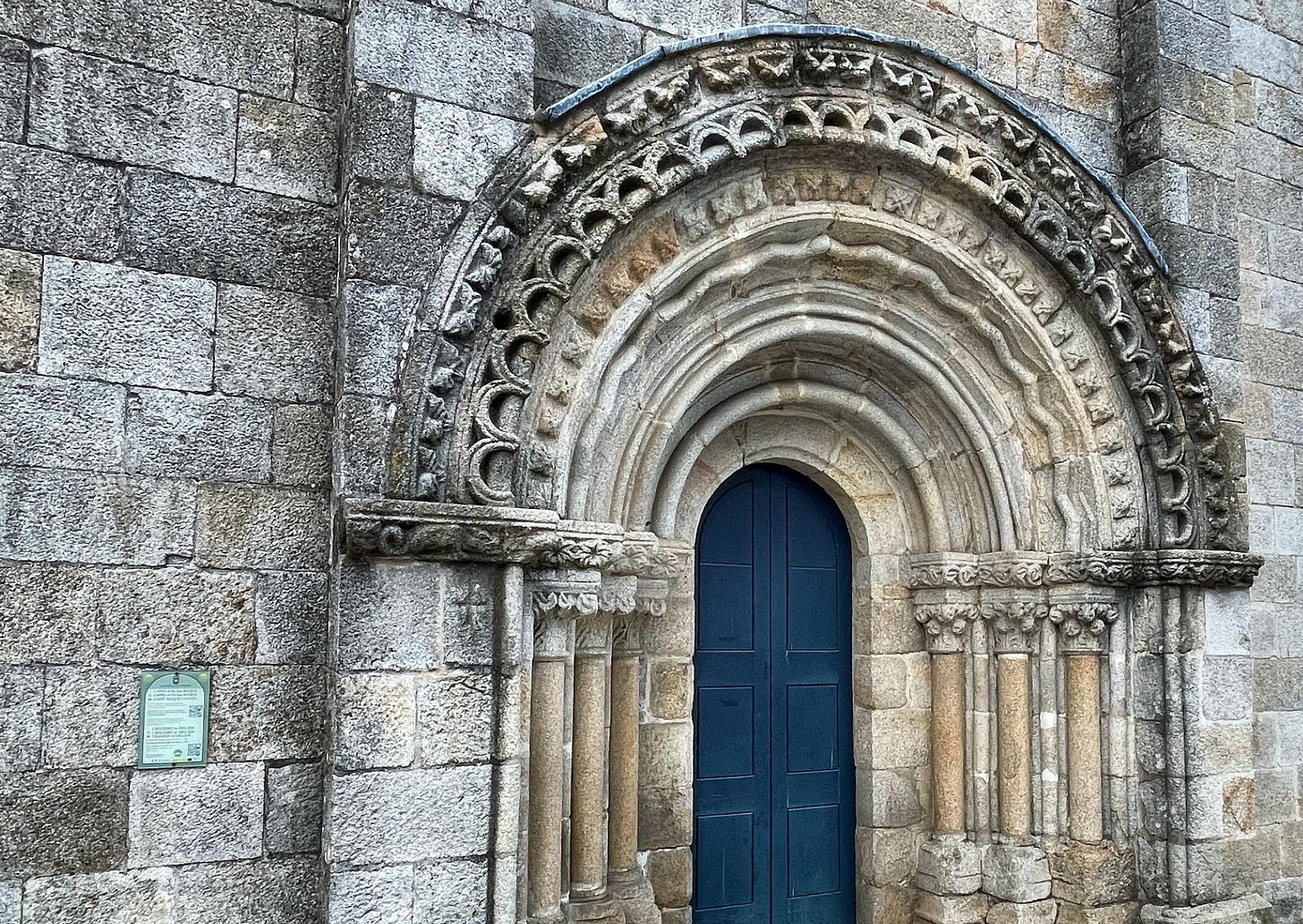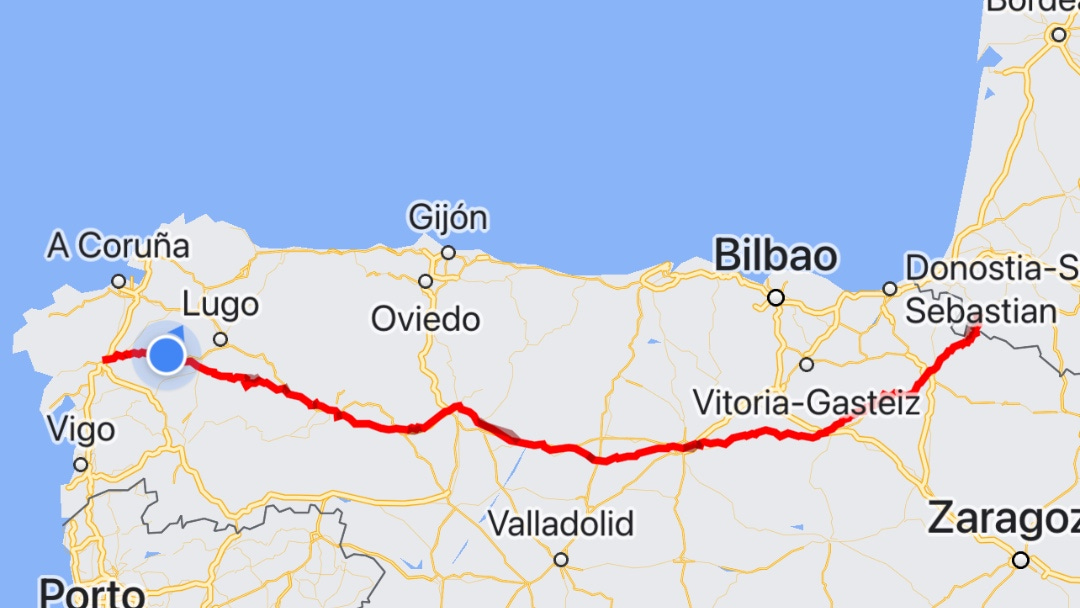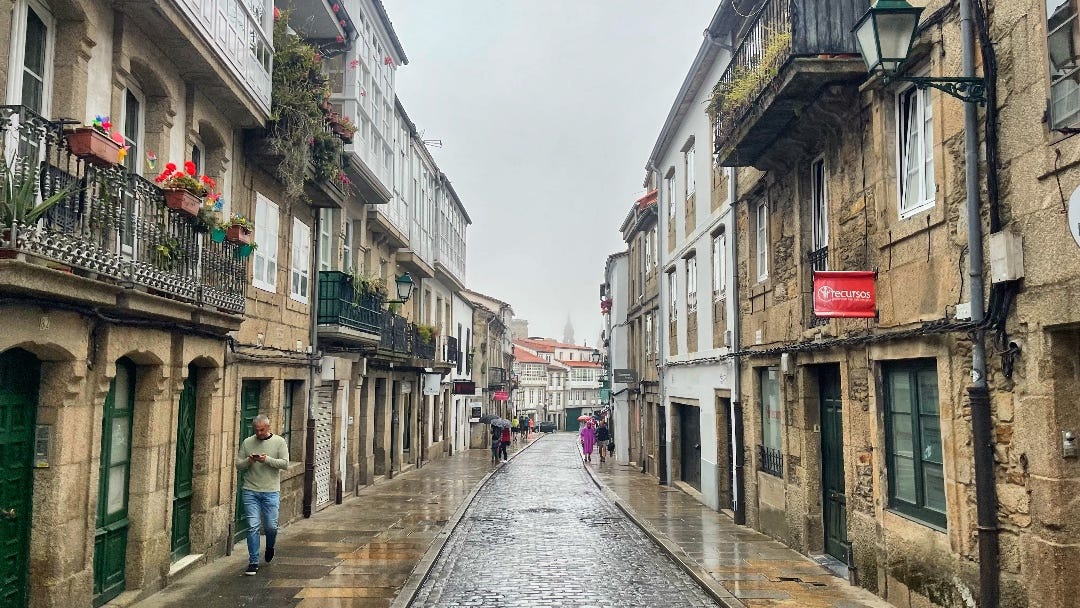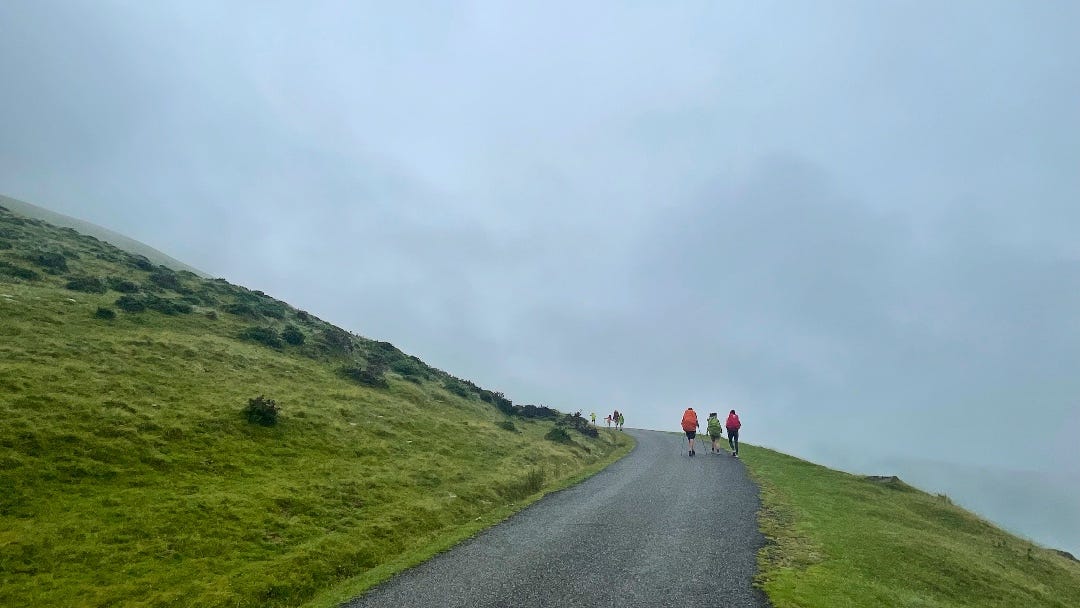On the day the world's news outlets all paid attention to the devastation caused by climate change, I ended my month-long journey to Santiago de Compostela, a tale of my world in beautiful Galicia and our troubled planet on that day.
On July 28, Typhoon Doksuri rushed into southern China, unleashing torrential rain and strong winds that uprooted trees, blew power wires, and started fires. Doksuri, originating in the Philippines and traveling across southern Taiwan, has already left a trail of devastation and death.
While Doksuri caused havoc in China, I am far away in Melide, Spain, where the weather is gentle, flowers bloom, and last year's unusual heatwave is already forgotten. My alarm clock wakes me up at 5:15 a.m. Compared to beautiful cities like Pamplona, Burgos, or Leon, Melide has little to offer visitors. Paradoxically, tourism is a central pillar of the city's economy, helped by the fact that this is the town where the classic Camino Primitivo merges with the Camino Frances, like lines in a Santiago shell that already join before reaching the revered end point of our efforts. These are two famous pilgrim pathways: the oldest and the most popular.
It was the morning after the Secretary General of the United Nations, António Guterres, who had for years desperately tried to convince the world's leaders to take urgent climate action, announced that the "era of global boiling has arrived." Scientists reported that July 2023 is on track to be the world's hottest month ever recorded.
Before six, I answer some emails, pack my bag, and walk out of the hostel into the dark morning. I pass one of the most admired examples of Galician Medieval art: the St Peter's church facade that now forms part of the Saint Roque Chapel built in the last century. I shiver in the cold air while thinking of the heatwaves in southern Europe that impact Spain just a few hours by train from where I am. Walking faster is not an option to get warm; the path gets rocky and uneven when I leave the city, and it is still pitch dark. So I guide myself by the light of my iPhone.
Meanwhile, wildfires raged further south on the European and African sides of the Mediterranean. Record fires in northern Algeria killed dozens of people. Scores of tourists were forced to flee from wildfires on the Greek island of Rhodes. And as if we needed any more convincing that we see the fingerprints of climate change in extreme weather events all over the planet, scientists of the World Weather Attribution Service found that the heatwaves in the US and Europe would have been "virtually impossible" in a world without climate change.
But on my path in northern Spain, I am happy when the darkness lifts and the short period starts when you can see shapes and contours, which makes walking easier. And only minutes later, this phase is followed by the time I can see where I am rambling, but there are hardly any colors yet. It's like the grainy view of the old black-and-white television in my parent's house when I grew up. Soon after, Galicia properly wakes up, and I can see green and the first colorful flowers in the lush landscape cut in slices by the handful of small streams and rivers that traverse the terrain.
Elsewhere in the world at that moment, scientists ate their breakfast before they started a new working day. They read the latest news about extreme weather on their devices while drinking their first cup of tea, and they shook their heads at the ignorance of the world's leaders that never took their pleas for urgent action seriously. Some of these scientists would focus this day on the different arguments for and against the possibility that the system of ocean currents that brings warm water from the tropics to the northern parts of the Atlantic Ocean could collapse in the following decades.
Galicia's climate would profoundly change, and we would see new and unrecognizable weather patterns. The Atlantic is next door to Galicia, and the region is a buffer for Spain against the ocean's weather systems that pound upon the Iberian Peninsula. But will the currents change? And when and how? Scientists would wish for more data for their research. Still, for some of these experts, a developing pattern indicates a possible disruption of the Atlantic Meridional Overturning Circulation.
What will this mean for the Camino de Santiago? For more than 1200 years, millions of pilgrims walked to the presumed grave of Saint James. The "little ice age" couldn't stop them. Now that the pilgrimage is likely more popular than ever, the conditions that define the walking conditions may change dramatically this century. So much is threatened by climate change: food, water, human and international security, and ultimately many lives. One more to add to this list is our cultural, historic achievements. It is not just the physical expressions like the city of Venice; it will also impact centuries-old cultural traditions like the pilgrimage to Santiago de Compostela. The route is also dotted with numerous churches, monasteries, and shrines, each with its own history and significance. The cultural and religious importance of the Camino Frances makes it an essential part of Spain's heritage and a cherished tradition for many around the world.
At eight in the morning, I have my first coffee and then continue to cross small streams over ancient bridges. I pass vineyards and even banana trees. An hour later, I note the 13 walked kilometers on my GPS tracker in less than two-and-half-hours of walking. I am below the usual morning pace of six kilometers per hour during the first few hours of hiking; the darkness slowed me down. But from Arzua onwards, the masses of pilgrims reduce my pace significantly.
While in the first hours, I had been entirely alone in nature, suddenly, the Spanish pilgrims that had started in Sarria only days before joined the Camino again. Huge lines form to get a stamp in their pilgrim passport, and when they walk again, the radios are turned on, and the roads are blocked since they all walk next to each other instead of behind each other, leaving no room for others to pass.
It's a slow procession. I am a visitor to their country, and to a large extent, I witness their religion and culture. And they enjoy it; I see a lot of happiness alternated with some suffering from blisters on untrained feet. I don't judge; I walk on, meandering from left to right, aiming to grab the opportunity to slip through their ranks to a more forward position.
The sun doesn't wait for my maneuvering; it rises above the horizon and gets warmer. The pollution we create in the atmosphere lets the sun's warmth enter but traps it on its way out like a blanket keeps you warm in winter; we have devised a global-scale warming greenhouse where the trapped energy increasingly shows its capacity to disrupt weather systems. I walk on a warming planet, likely warmer now than ever in more than 100,000 years.
The many small cafes along the route can't deal with the waves of pilgrims, there is no place for me, and I continue several times when I would have liked to stop. But I keep my pace through forests, fields of wheat and corn, and via hollow roads as you would find them in the Irish countryside. I pass thousands of pilgrims, and not once am I passed by another.
Now, days later, I am looking back at Friday, July 28. I believe it was then, surrounded by the masses of pilgrims in the early afternoon, that I realized I didn't see a familiar face all day, which made it the first day on my monthlong walk that I didn't recognize anyone. I conceded this was no longer my walk; I felt lonely for the first time on my Camino while walking between the thousands of people.
It was then that I decided that this should be my last day. I would continue walking until I reached Santiago, forget about my blisters, and ignore a reluctant knee that was always the first to complain about my walking plans.
In the afternoon, the waves of pilgrims ebbed as quickly as they had appeared, leaving me alone on the path. It started to rain, first a drizzle, then more. I kept walking and passed closed cafes and a lonely slow-walking woman from Texas, eager to finish today but realizing it would be very late for her when she reached the cathedral with the small steps she could still take.
I continued, passed the airport of Santiago, and walked again on a forested trail until I reached the city's outskirts and the Monte del Gozo, from where for centuries, the pilgrims could see the first glimpse of Santiago de Compostela. The rain was now pouring down.
Around half past seven, I saw the cathedral's spires, and as if Santiago personally recognized my endurance, the air cleared a little bit. Some 15 minutes later, I arrived at the Plaza del Obradoiro, the vast square in front of the cathedral where the Camino ends. There were hardly any other pilgrims. They tend to come in the morning and early afternoon, and in this weather, they had all flocked to the hostels and restaurants of the city.
I had walked 57 kilometers and then added one more to get dinner and find a taxi. It's 36 miles, a lot for one day. But the earth is also enduring a lot each day. The planet doesn't bother us with blister stories, nor are the ever-growing numbers of people that suffer from the weather extremes caused by our structural reluctance to take timely action against the global climate change disaster.
For one month, I lived a secluded life of walking, drinking lots of coffee, talking to new friends, and sleeping short nights. All the time, I was aware of the privilege of being able to do this in a year when suffering became the norm for many. Reading the news on my phone during stops on the route reminded me daily about the disastrous proportions of our collective destruction of the planet.
On the Camino, I heard heartbreaking stories of loss and unfairness. Many struggle to find a new balance, inspiration, and transformation during one or two months of walking. I'm fortunate to be happy, healthy, and writing for you is the best job I could wish for. But I have my worries too, less personal perhaps and therefore unlike the stories of most other pilgrims. Still, these worries are at such a large scale that it is hard to grasp for many why I feel grief about this planet while enjoying its spectacular beauty at the same time.
The dichotomy between enjoying the planet's beauty while it lasts and fighting to preserve all we may lose will likely stay with me for a long time. I am still looking for answers, but following this 800-kilometer-long route has given me new motivation to continue on the track that I am already on. Please continue to join me on this journey.
If you got this far, please read this too:
I write this newsletter because I believe that together we can do better on this beautiful but fragile planet.
If you are a paying subscriber: thank you for your support!
If you are not, please consider supporting this initiative by taking a paid subscription.
The Camino Francés: Balancing Appreciation for Nature and the Inner Self
I left the picturesque town of Saint-Jean-Pied-de-Port a month ago when I stepped over the triangular Camino marker in the pavement and through the old Spanish Gate early on June 29. It was my start of the Camino Francés, the renowned "French Way" to Santiago de Compostela. It is the most popular route among…
















Excellent piece, Alexander. I could genuinely feel your emotions through your words, and I share the mixed feelings of frustration with our global inaction while truly enjoying the beauty and mystery of the natural world on our amazing planet. Feeling lonely amongst the masses of pilgrims was quite evocative, and made me reflect on how many people must feel that way every day - a reminder to me to smile and be kind whenever possible (which should be always). I am happy for you that you have successfully navigated the Camino Frances once again, and send best wishes for the remainder of your journey. It has been a pleasure to join through your writings and photos.
You write :«The dichotomy between enjoying the planet's beauty while it lasts and fighting to preserve all we may lose will likely stay with me for a long time. I am still looking for answers, but following this 800-kilometer-long route has given me new motivation to continue on the track that I am already on. » and that’s it !
Thanks for this, your commitments and many wishes for a happy birthday today.